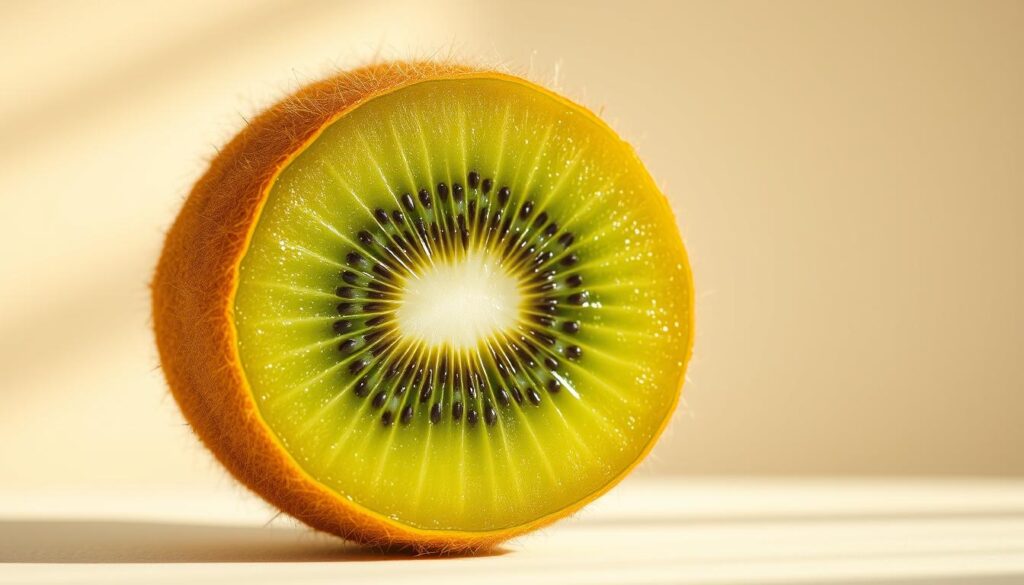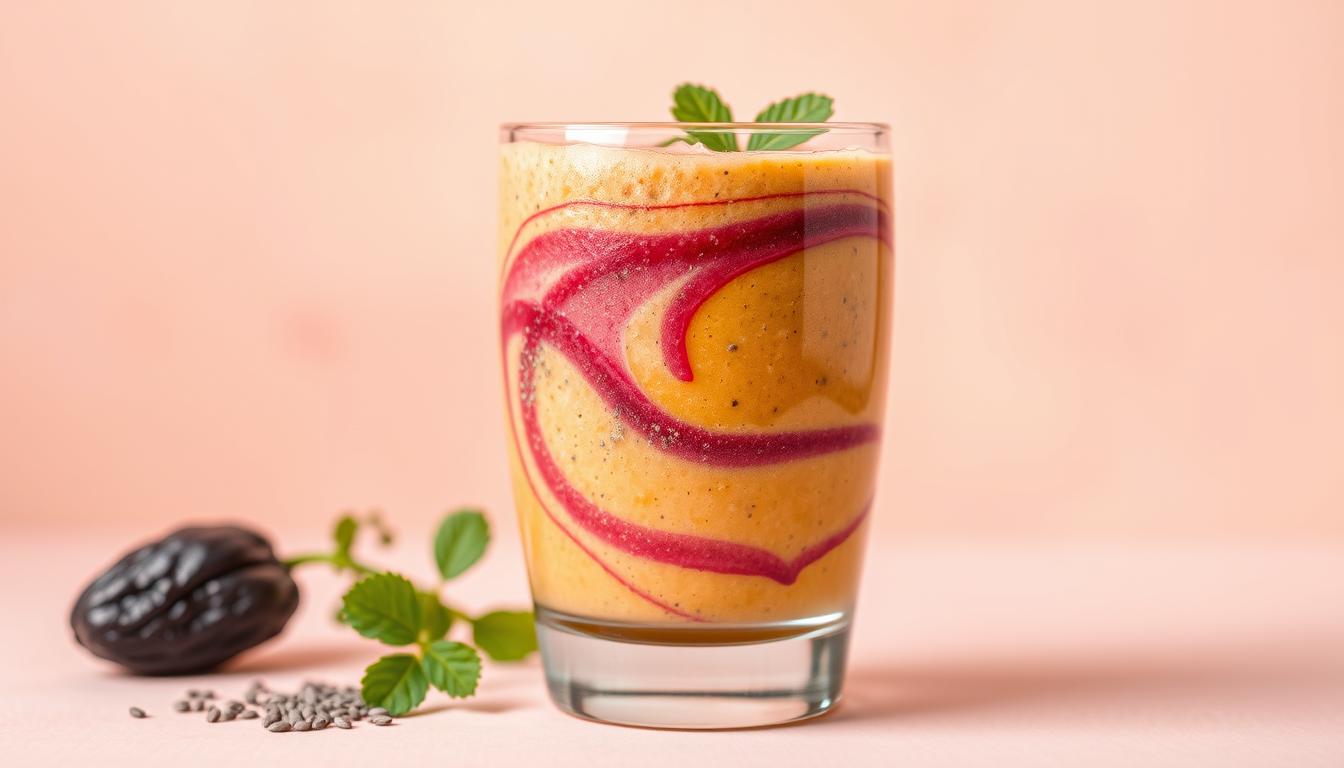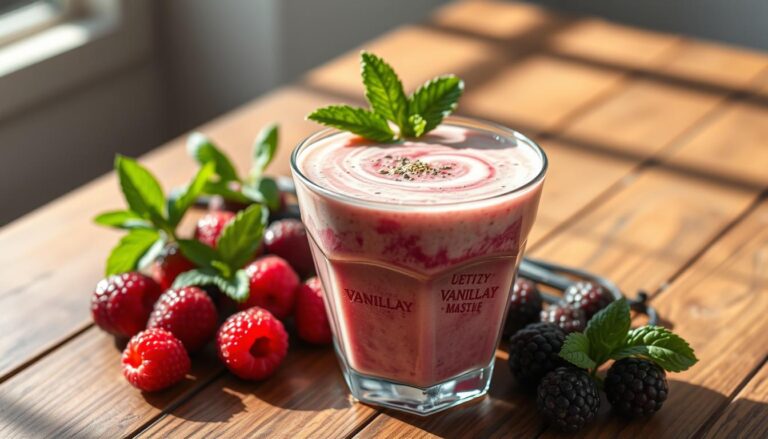Are Smoothies Good for Constipation is the question many vegan people ask when they want gentle relief without laxatives.
Think fiber plus water: a blended cup can combine both to soften stool and add bulk, helping your gut move more easily day to day.
Constipation usually means fewer than three bowel movements per week with hard, dry stools and symptoms like bloating and cramping. Fiber adds bulk and fluids keep stool from drying out.
Research and studies point to kiwi, berries, ground chia, and flax as evidence-informed picks that support the gut and offer milder effects than strong laxatives. Sorbitol in some fruits can draw water into the bowels to soften stool.
This guide gives practical tips, exact cup and tablespoon measures, and quick blender steps using vegan-friendly ingredients and plant yogurts. You can make low-sugar, IBS-aware options that fit busy mornings or anytime you need fast support.
Try the smoothie generator to build a vegan recipe in seconds: https://healthconservatory.com/smoothie-generator
Key Takeaways
- Smoothies blend fiber and water to ease stool movement.
- Kiwi, berries, chia, and flax have research-backed benefits.
- Measure cups and tablespoons for reliable results.
- Options exist for low-sugar and IBS-aware needs.
- Use the smoothie generator to customize a vegan cup in minutes.
Are Smoothies Good for Constipation is your vegan-friendly guide to quick, gentle relief
In minutes, you can mix a plant-powered cup that blends fiber, fluids, and healthy fats to ease stool movement. This post turns the question into a clear vegan plan with exact measures, practical ingredients, and fast steps you can use today.
What you’ll get: a base constipation smoothie recipe with cup and tablespoon measures, plus simple swaps for thickness and sweetness without added sugar. Frozen fruit makes texture and chill better; add extra water or plant milk if the blend is too thick.
How this recipe post serves your needs today
- Step-by-step recipe timing so you can blend in minutes before work.
- Ingredient guidance: kiwi, berries, chia, flax and nondairy yogurt with live cultures.
- Practical tips on choosing plant milk and reading labels for active cultures.
- IBS-aware and low-FODMAP tweaks, plus prep-ahead options.
Try building a personalized vegan constipation smoothie now: https://healthconservatory.com/smoothie-generator
How vegan smoothies help constipation: fiber, fluids, and friendly fats
Blending whole fruits with fluids turns dry fiber into a gel that eases passage through the intestines. That gel adds bulk while water keeps stool soft, so transit time shortens and discomfort drops.
The fiber-fluid partnership to reduce transit time
Think “bulk plus gel.” Insoluble fiber adds volume; soluble fiber forms a gentle gel. Together they make stool easier to move.
Pair fruit fiber with a cup of plant milk or water in your smoothie to hydrate the fiber. Proper hydration prevents hard, dry stools and supports regular rhythms.
Seeds that help constipation: chia and flax as daily staples
Ground flax and pre-soaked chia seeds add both soluble and insoluble fiber plus omega-3s. Use ground flax or soaked chia to boost absorption and keep the drink smooth.
Fruit choices that move the gut: kiwi, berries, mango, and prunes
Kiwi stands out: its fiber and the enzyme actinidin help motility with fewer side effects than prunes or psyllium for many people.
Blackberries, stone fruits, and some berries contain sorbitol and polyphenols that can draw water into the bowel and feed healthy microbes. Mango adds creamy texture and soluble fiber to balance seeds and kiwi in a reliable recipe.
“Consistency matters — a few blended cups per week, plus hydration and movement, builds real benefit over time.”
Vegan constipation smoothie ingredients that work
Choose ingredients that mix fiber, moisture, and healthy fats to make a filling, gut-friendly cup.
High-fiber fruits to start with: kiwi, blackberries, blueberries, raspberries, and mango. These fruits supply both soluble and insoluble fiber; blackberries also contain sorbitol to help soften stool.
Plant-based milks and yogurts
Pick almond, soy, or oat milk for creaminess and calcium. Scan labels and choose plant yogurt with live cultures to mimic probiotic effects seen in some dairy products.
Seeds and healthy fats
Rotate chia, ground flax, and hemp seeds for diverse fiber and omega‑3s. Add avocado or a tablespoon of almond butter for soluble fiber and silky texture.
| Ingredient | Portion | Key benefit |
|---|---|---|
| Mixed berries | 1–1.5 cups | Fiber + vitamin C |
| Plant milk | 1 cup | Hydration + creaminess |
| Ground flax / chia | 1–2 tbsp | Soluble fiber, omega‑3s |
| Avocado | ¼–½ | Healthy fats, silky body |
Practical tips: use frozen fruit for thickness, keep ground flax cold to preserve oils, and avoid high-sugar labels so your cup stays fiber-forward. Choose ingredients you like so the habit lasts.
Constipation smoothie recipe (vegan)
This vegan recipe gives one large, gut-friendly serving you can blend in under ten minutes. It focuses on fiber, fluids, and gentle fats to ease stool passage without strong laxatives.
Yield, time, and equipment
Yield: 1 large serving. Total time: about 5–10 minutes. Equipment: standard blender, measuring cups, and spoons.
Exact ingredient list (US measures)
- 1–1.5 cup frozen fruit (example: 1 cup frozen berries + 1 peeled kiwi)
- 1 cup plant milk (almond, oat, or soy)
- 2 tablespoons chia seeds or ground flax
- ¼–½ small avocado
- Optional: 2 tbsp unsweetened plant yogurt (live cultures) — reduce milk by ½ cup if used
- Optional thin: splash of water
| Item | Measure | Purpose |
|---|---|---|
| Frozen berries + kiwi | 1–1.5 cup | Fiber + sorbitol to soften stool |
| Plant milk | 1 cup | Hydration and creamy texture |
| Chia seeds / flax | 2 tablespoons | Soluble fiber, thickening |
Blend 30–60 seconds until smooth. Rest 1–2 minutes if chia seeds need to thicken. For IBS tweaks, use raspberries and keep avocado to ¼. For more tailored options and pantry-based swaps, try the smoothie generator now: https://healthconservatory.com/smoothie-generator
Step-by-step: blend smooth in minutes
Quick, repeatable steps make it easy to get a creamy cup every day. Start each blend with the liquids—this helps the blades move and prevents clumping.
Blender order and early checks
Add liquids first: pour plant milk or a splash of water so the blades catch and the motor runs easily.
Layer soft items next: kiwi, avocado, or yogurt. Finish with frozen fruit and seeds on top to form a steady vortex.
Texture checks and quick fixes
- Start on low, then ramp to high for about 30–60 seconds; stop to scrape sides if needed. Aim to blend smooth so no seed flecks remain.
- If it’s too thick, add 1–2 ounces of water or plant milk, then pulse and recheck.
- If it’s too thin, add a handful of frozen fruit and blend again for a thicker pourable texture.
- Use ground flax for the silkiest result. If you use chia, let the cup rest 1–2 minutes to thicken, then blend once more.
- Soak dates 10 minutes in hot water before blending to avoid grainy bits.
Practical tips: most blends take just a few minutes, especially with pre-portioned freezer packs. Clean the blender right away with warm water and soap to save time later.
Vegan swaps, low-sugar tweaks, and IBS-friendly options

Simple, low-sugar swaps help you keep a filling cup that supports regularity without upsetting sensitive digestion.
Choose plant yogurt labeled with live and active cultures to capture probiotic benefits without dairy. Some products mimic strains like Bifidobacterium lactis found in Activia, which has been shown to reduce transit time.
Pair that yogurt with almond, soy, or oat milk to keep the blend vegan and creamy.
Low FODMAP-inspired swaps and portion guidance
If you’re IBS-prone, build recipes that favor kiwi and raspberries and reduce avocado to about a quarter or half depending on tolerance.
Lean on ground flax and chia as gentle seeds that boost soluble fiber. Start with smaller seed amounts and increase as you adapt to avoid discomfort.
- Use unsweetened plant milk and yogurt and rely on berries and kiwi to lower sugar.
- For a nutty boost, add 1 tablespoon almond butter for creaminess and satiety.
- Omit dates or stone fruits if they trigger symptoms and start with half a cup if you’re new to high fiber.
Practical tip: Keep a short list of tolerated ingredients and track how your body reacts after different recipes and times of day. Small tweaks can improve comfort and regularity over time.
Taste and texture tips without added sugar
Texture matters as much as flavor. Use creamy add-ins and frozen fruit to get a silky mouthfeel that feels indulgent without adding sugar.
Build sweetness from whole fruit. Rely on berries, kiwi, and a little mango to balance acidity and keep added sugar at zero. If you want extra natural sweetness, a very ripe banana or an extra half cup of frozen mango works well.
For a luscious body, add 1/4 avocado and about 1 cup frozen fruit. Blend a bit longer so seeds disperse and the sip stays silky. Using unsweetened plant milks and plant yogurts helps you control total sugar while preserving creamy texture.
- Brighten flavor with lemon juice, fresh ginger, or a pinch of cinnamon to lift the profile without changing digestion.
- Keep ingredients cold; a few ice cubes add froth if you use fresh fruit instead of frozen.
- Blend 30–60 seconds, pause, and blend again to avoid gritty seed bits and to improve mouthfeel.
- Pair vitamin C–rich fruit like berries plus kiwi to boost brightness and support overall wellness.
Prep freezer packs with pre-measured fruit and avocado slices so you can drop, blend, and sip quickly. These small steps make a low-added-sugar cup taste fresh, smooth, and satisfying every time.
Are Smoothies Good for Constipation in light of recent studies

New studies have tested kiwi, berries, and seeds against common treatments and report promising, milder results.
What trials show: an exploratory trial found green kiwi improved bowel frequency and comfort compared with prunes and psyllium. Kiwi appears to help with fewer side effects while boosting regularity.
Berries support healthy gut microbes, and that can influence stool form when combined with fiber-rich seeds. Chia seeds and ground flax have clinical support as convenient sources of soluble and insoluble fiber.
Dietary patterns, daily targets, and practical timing
Multiple lines of research point to fiber plus fluid as the cornerstone. Smoothies offer a reliable way to deliver both each day.
- Aim to meet daily fiber through fruits, vegetables, legumes, whole grains, and seeds.
- Many people find a morning smoothie pairs with the gastrocolic reflex and helps create a morning routine.
- Start with half portions if you’re new to seeds to limit bloating; increase to 1–2 tablespoons as you adapt.
| Component | Example | Purpose |
|---|---|---|
| kiwi | 1 small | Improve stool frequency |
| Fruit + seeds | 1–1.5 cups fruit, 1–2 tbsp seeds | Fiber + water delivery |
| Timing | Morning | Matches natural gut rhythms |
Practical takeaway: treat this as a consistent framework — about a cup of plant milk, 1–1.5 cups fruit, and 1–2 tablespoons of seeds — and track your response over a few days to find your ideal mix.
Conclusion
Finish with a simple routine: a daily cup that mixes fiber, fluid, and a little healthy fat can shift bowel habits over days.
Keep it simple. Aim for a basic constipation smoothie: 1–1.5 cups frozen fruit, 1 cup plant milk, and 1–2 tablespoons of seeds like chia or ground flax. Add 1/4 avocado or a tablespoon of almond butter for satiety.
Follow the blender order, blend 60–90 seconds to blend smooth, and adjust thickness with milk or extra cup frozen mango. These small dietary additions stack up and can help constipation without harsh measures.
Ready to personalize? Build your ideal smoothie recipe in minutes with our generator: https://healthconservatory.com/smoothie-generator




